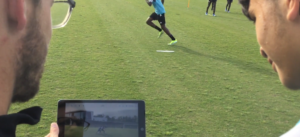05.06.24Matt Lawrey and the Effort to Help Athletes Learn to Watch Better

Teaching David to watch more intentionally
A few weeks ago I spent a day at Atlanta United’s Academy with Matt Lawrey, one of my favorite coaches and talent developers.
In the afternoon we joined Will Bates, who was coaching the U15s, to experiment with a few ideas we are both interested in.
We’ve talked in the past about trying to socialize players to watch better and more intentionally so they learn more during “down times” in training.
We both think this is an untapped area for development. Consider how much time players spend watching. You are rotating three teams through an 8v8 game for example. Are the 8 players who are “off” watching what’s happening on the field? Are they watching passively or with their attention specifically tuned to things that are maximally useful? How much do they watch for the technical details and off the ball movements?
What about the players during a match? Are they watching to see what tactical decisions your team or the opponents are making or are they watching to see who wins? Are they watching actions away from the ball?
Watching presents an especially beneficial opportunity to watch and learn in those areas specifically.
So one goal was to socialize better watching habits.
We’ve also talked about using an ipad to show players themselves in practice so they could learn by watching themselves and just maybe seeing what their coaches or teammates see.
We were particularly interested in areas of the game that don’t provide “implicit feedback.” For example, you get much better implicit feedback for actions when you are on the ball. If your pass was good or your shot dangerous, you tend to know it. You can see the result. The outcome tends to reinforce what you’ve done in a mostly logical and reliable way.
But in other areas of the game the implicit feedback process is less reliable. Your movement off the ball for example: you are less likely to realize that your movement could have been sharper or created more space for a teammate. Or you might make an excellent movement but still not get the ball and therefore not know that you’d done well.
On a previous visit, then, with U17 coach Steve Covino, we’d experimented with videotaping players off the ball and gathering them to show them their movements off the ball on the ipad… asking them to evaluate the quality and timing of their movements. Could we make a relatively invisible part of players’ lives more visible to them to help them learn?
Will’s session featured significant work on defending so Matt decided to try applying these two ideas to see if he could help players see their defensive body position and movements more clearly. To learn to watch for them more in this practice and ideally in the future.
In this video Matt is standing with Dulani, who is about to take his turn in a short field transition game.
His goal is to initiate a conversation with Dulani and cause him to watch the defender who is playing the role he is about to play with more intentionality and attentiveness to key cues.
Notice how relaxed Matt’s questioning style is. How much space he leaves for Dulani to observe. How he makes it relaxed and safe. Notice also how much of the conversation is about cues—what Dulani should be looking for in other situations like these. And how much Dulani grows into the conversation. First he’s just answering Matt’s questions but soon enough he’s initiating the discussion, describing things he sees unprompted and even orienting his body to rehearse proper body position.
In the first video Matt was trying to socialize players to watch well during down time and arming them with cues.
In this next video Matt is now using an ipad to show players their own actions in an individual defending exercise. Before they play again Matt shows them their last round and asks them to analyze.
In this clip, Matt’s first question is: What do you think? This allows him to assess what Josh knows and attends to in observing defensive actions. notice how much the player, Josh, starts to spontaneously narrate what he sees. He’s narrating back each of his actions. In a couple of cases “What’s the timing of your step?” “What’d you do right after?” to help remind Josh of the key principles of defending but Josh seems to know. Still its so powerful to see himself taking the actions and succeeding. He’s building a mental model of what his body should do. Lastyl notice how fast the interaction is. Matt doesn’t belabor it. He wants Josh to see and watch attentively and then get back to playing.
In this last clip Matt is working with David.
I love this clip because you can see how deftly Matt uses the video to play the sequence David is studying over for him multiple times, slowly, repeating, letting him look at it carefully and notice details in key moments. First he orients David to look for his body positioning. After pointing out an area for improvement he asks about something David did well (timing of tackle) so he can replicate it. And then he tells him to watch again but orients his attention so he notices something he did well: “This time watch your feet.” It’s so important to use feedback to help players see what it looks like when they do things right so they keep doing it!
And then as before, David goes right back out and tries to use what he’s learned.
Thanks to Matt and Will, their players and everyone at Atlanta United!
